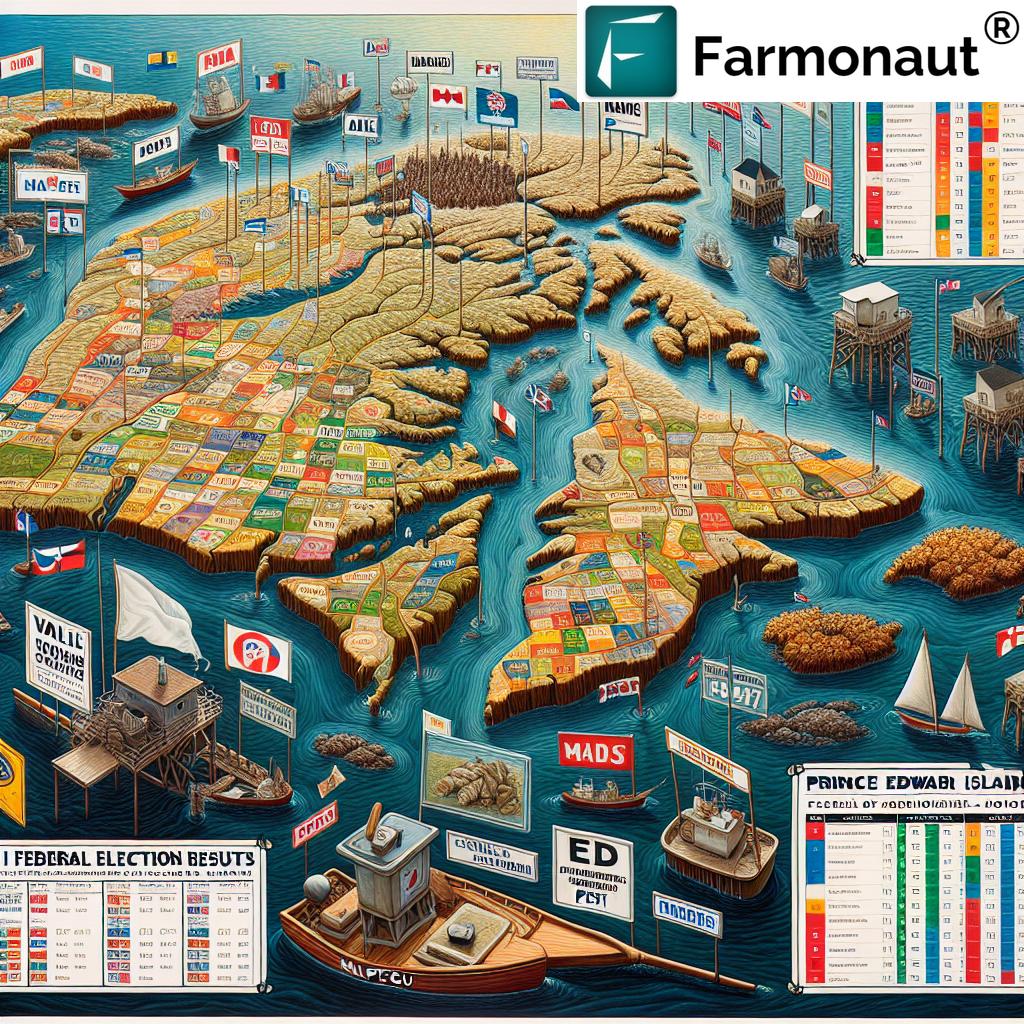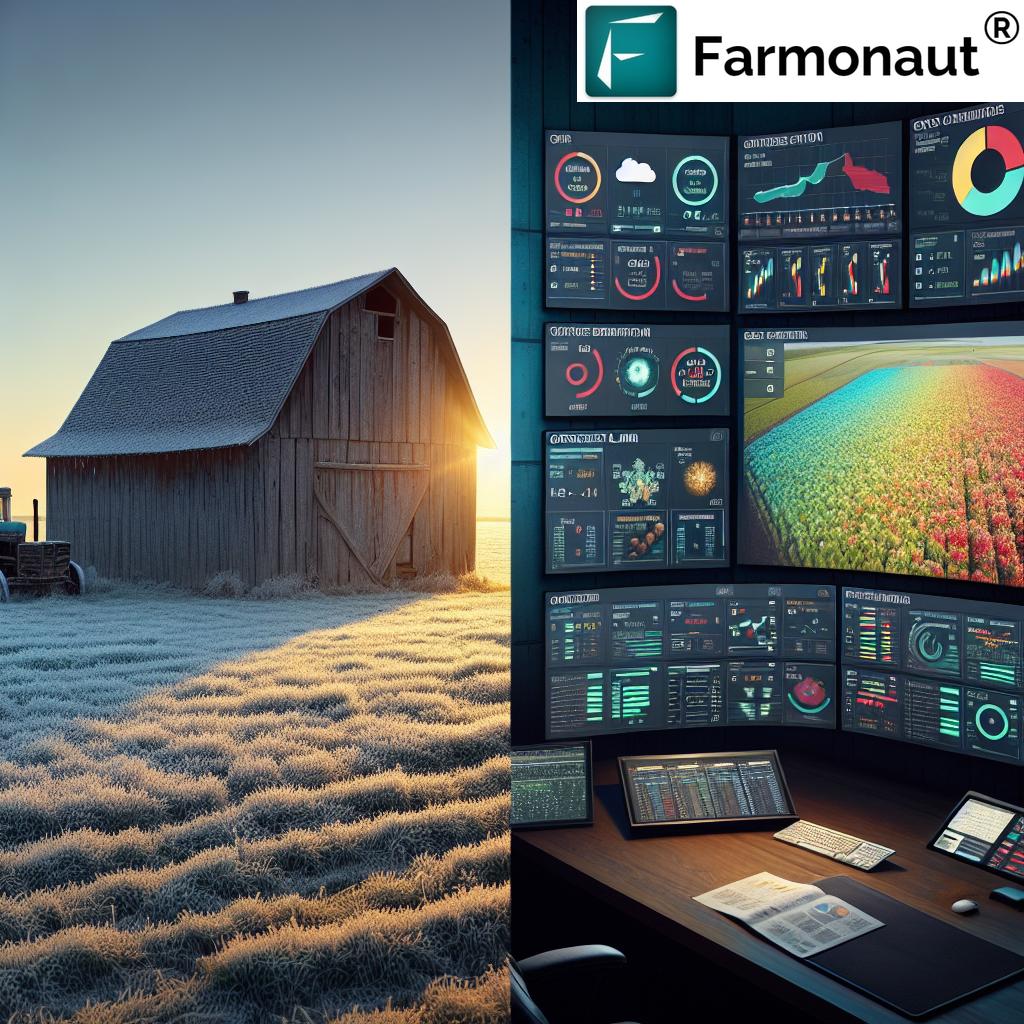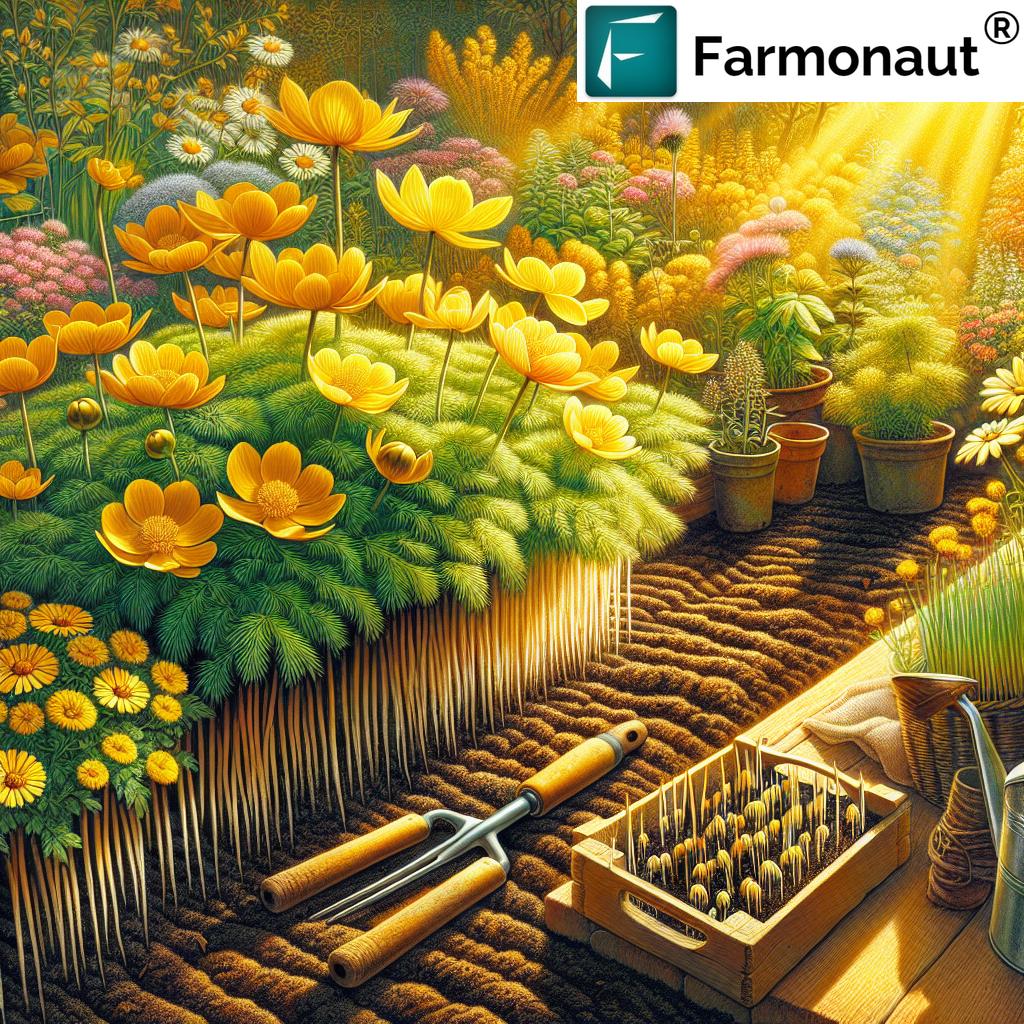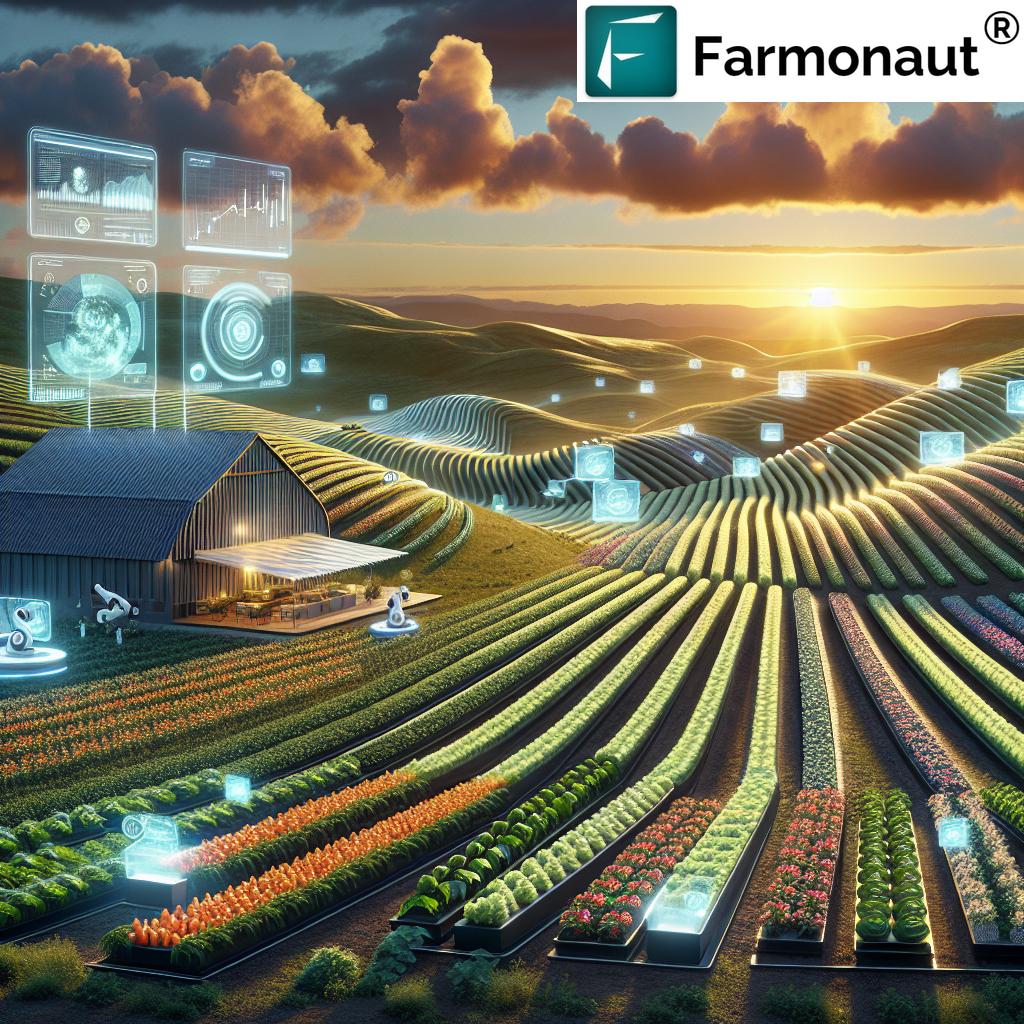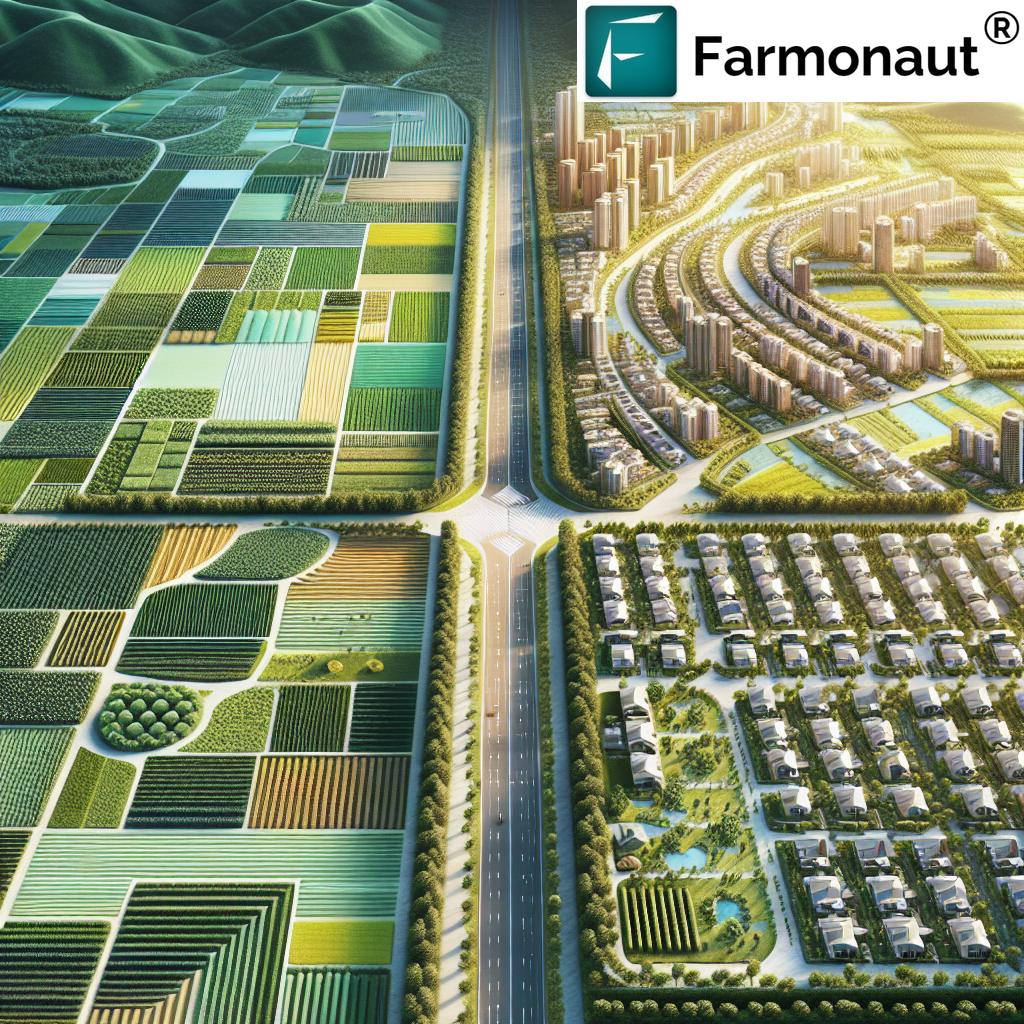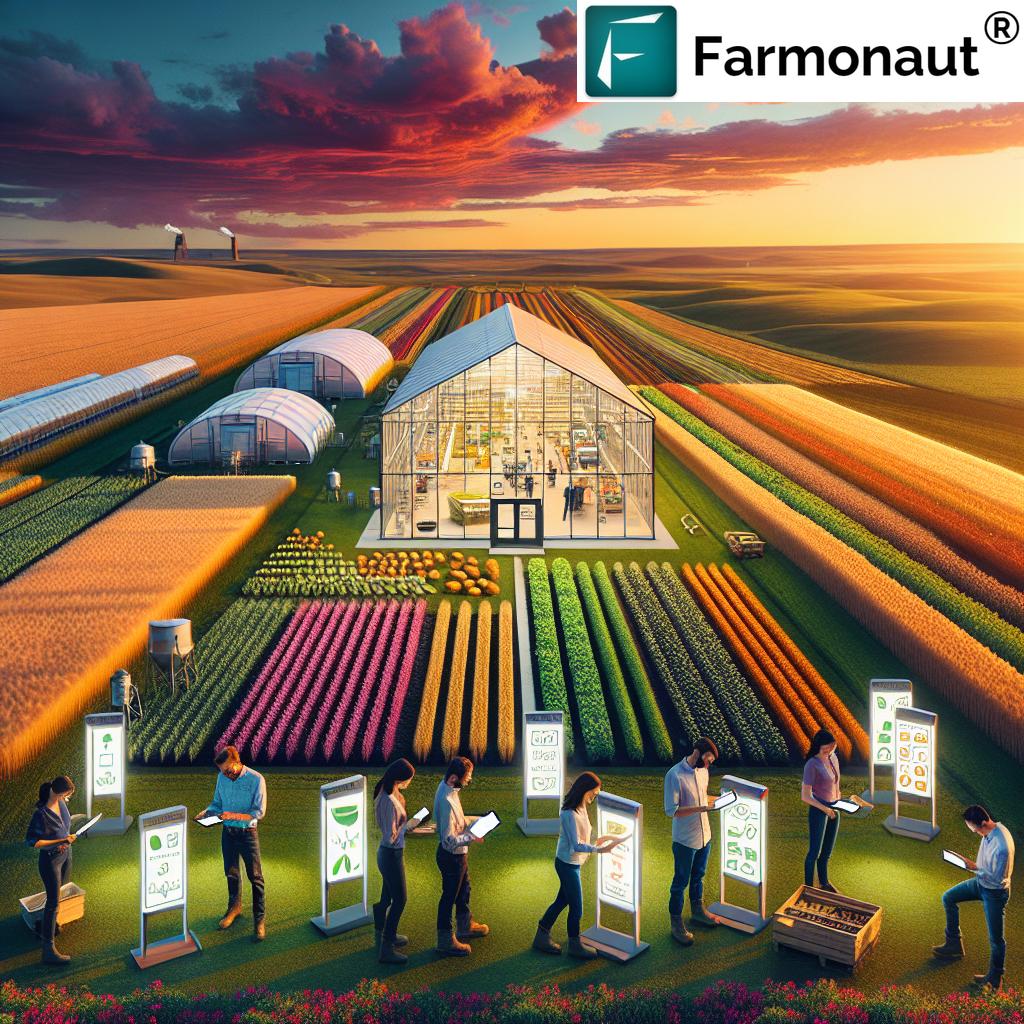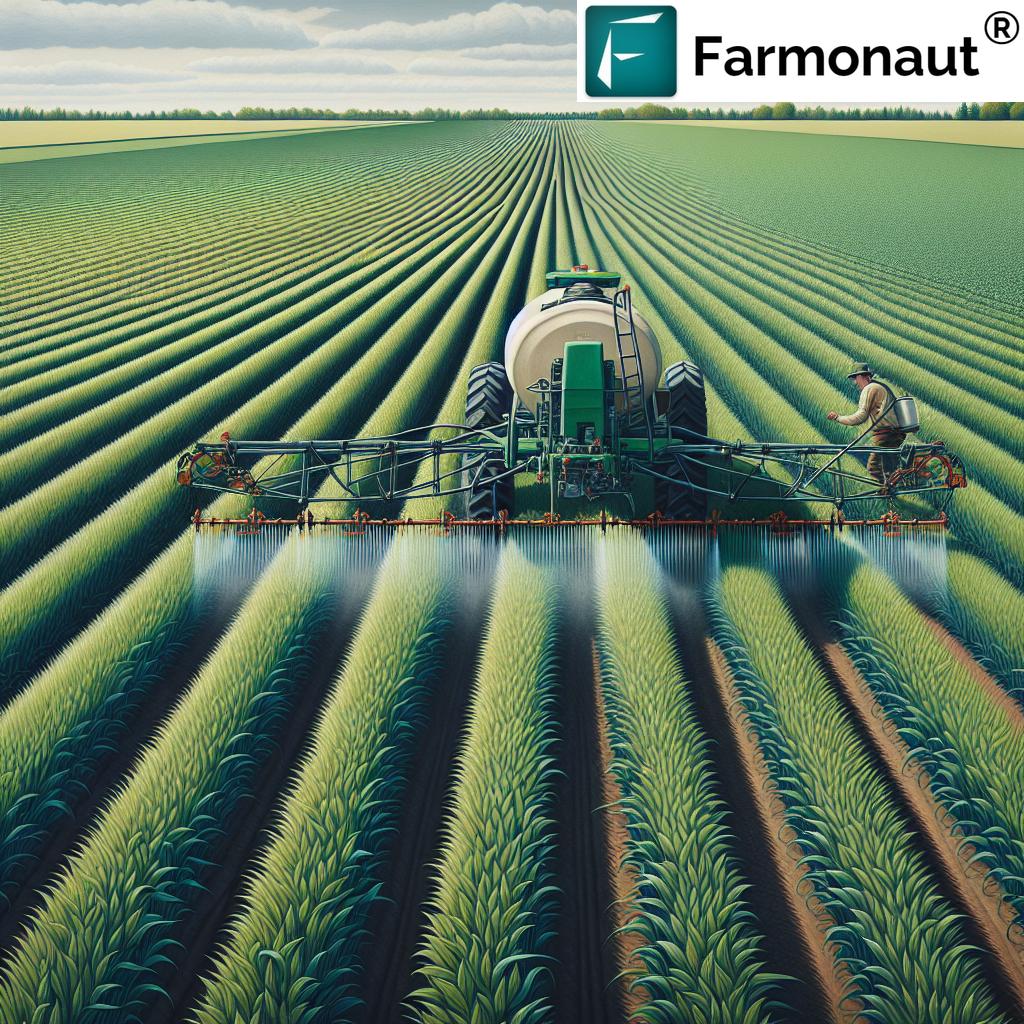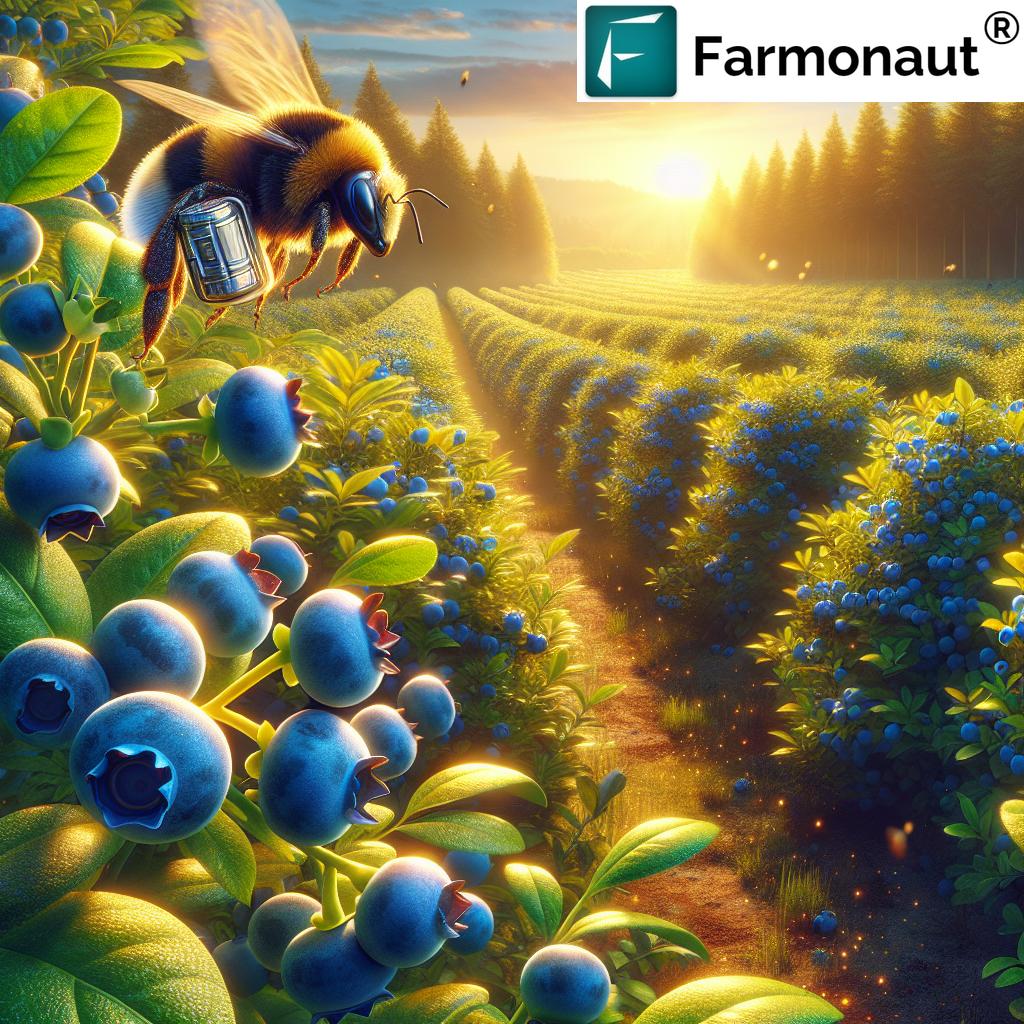Revolutionizing Agriculture: How Bee Vectoring Technology is Transforming Sustainable Farming in Mississauga, Ontario
“Bee vectoring technology can improve crop yields by up to 30% while reducing chemical pesticide use by 80%”
Welcome to the future of agriculture! We’re excited to explore the groundbreaking world of bee vectoring technology and its transformative impact on sustainable farming practices in Mississauga, Ontario, and beyond. As leaders in agricultural innovation, we at Farmonaut are committed to bringing you the latest industry news and scientific advancements that are shaping the future of farming.
In this comprehensive blog post, we’ll delve into the fascinating intersection of nature and technology, uncovering how bee vectoring is revolutionizing crop protection, enhancing yields, and promoting eco-friendly pest management. From blueberries to sunflowers, we’ll explore the diverse applications of this cutting-edge technology across various crops and its potential to address global food security challenges.
Understanding Bee Vectoring Technology
Bee vectoring technology is an innovative agricultural solution that harnesses the power of bees for both pollination and biological crop protection. This groundbreaking approach integrates seamlessly with integrated pest management strategies, offering a game-changing alternative to traditional farming methods.
- Utilizes bees as natural delivery systems for beneficial microbes
- Combines pollination services with crop protection
- Reduces reliance on chemical pesticides
- Promotes sustainable farming practices
At the heart of this technology are smart hives equipped with proprietary dispensers. As bees exit their hives, they pass through these dispensers, which coat their bodies with a fine powder containing beneficial microorganisms. These microbes are then naturally distributed to plants as the bees carry out their pollination activities.
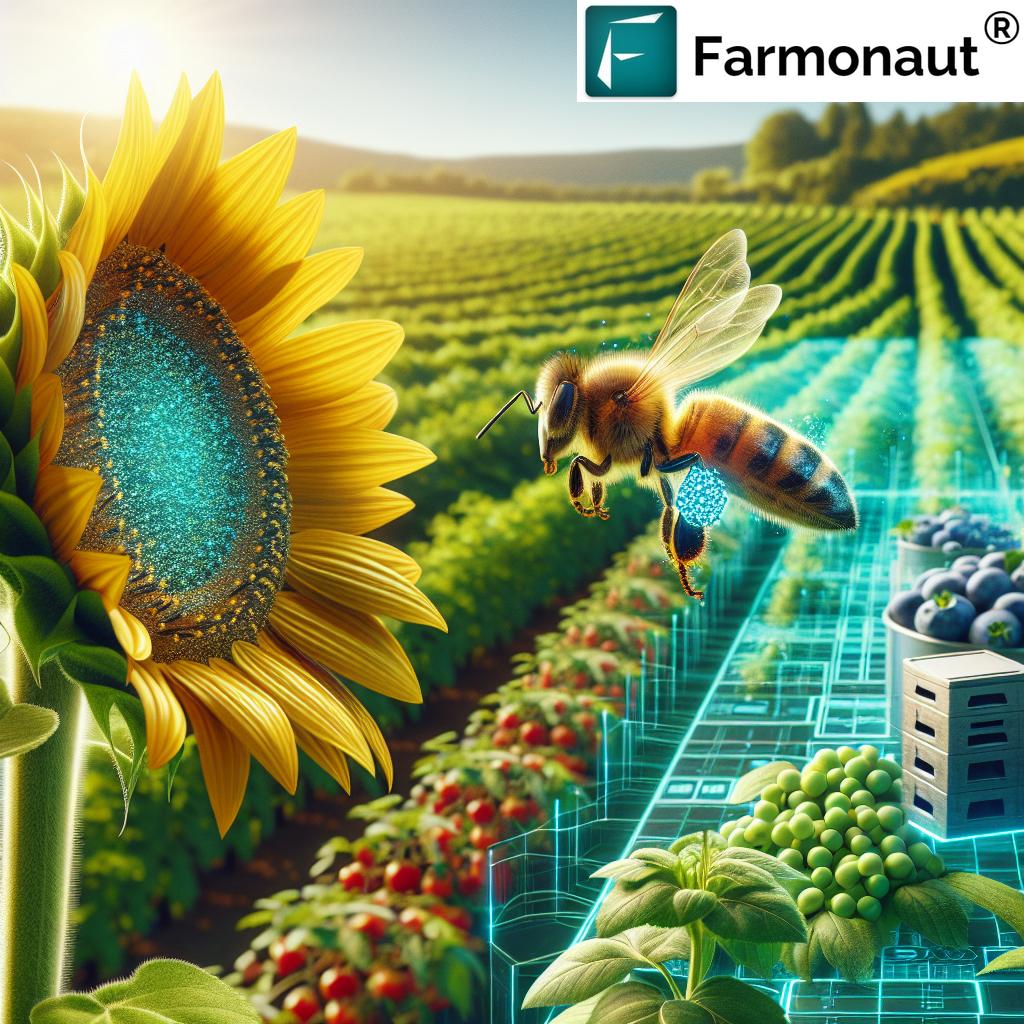
The Science Behind Bee Vectoring
Bee vectoring technology relies on the symbiotic relationship between bees, plants, and beneficial microorganisms. The process involves several key components:
- Proprietary Biologics: Carefully selected strains of beneficial fungi or bacteria that protect crops from diseases and pests.
- Smart Hives: Modified beehives equipped with dispensers that apply the biological agents to bees as they exit.
- Natural Delivery: Bees distribute the biologics to flowers during their normal foraging activities.
- Plant Protection: The beneficial microbes colonize the plants, providing long-lasting protection against pathogens and pests.
This innovative approach not only ensures precise delivery of crop protection agents but also maximizes the efficiency of pollination, leading to improved crop yields and quality.
Benefits of Bee Vectoring Technology
The adoption of bee vectoring technology offers numerous advantages for farmers, the environment, and the agricultural industry as a whole:
- Enhanced Crop Protection: Targeted delivery of biologics directly to flowers provides effective control against various pathogens and pests.
- Improved Pollination: Increased bee activity in crops leads to better fruit set and higher yields.
- Reduced Environmental Impact: Minimizes the use of chemical pesticides, promoting eco-friendly farming practices.
- Cost-Effective: Combines two essential agricultural services – pollination and crop protection – into one efficient process.
- Season-Long Protection: Continuous application throughout the blooming period ensures prolonged crop defense.
As we continue to face global challenges in food security and environmental sustainability, bee vectoring technology emerges as a promising solution that aligns with the principles of sustainable agriculture.
Applications Across Various Crops
Bee vectoring technology has shown remarkable versatility, proving effective on a wide range of crops. Some of the key applications include:
- Blueberries: Enhances fruit quality and protects against fungal diseases.
- Strawberries: Improves yield and provides defense against gray mold.
- Sunflowers: Boosts seed production and offers protection against various pathogens.
- Almonds: Increases nut set and helps control fungal infections.
- Canola: Enhances seed yield and provides resistance to sclerotinia stem rot.
The adaptability of this technology to different crop types demonstrates its potential to revolutionize farming practices across diverse agricultural sectors.
Bee Vectoring in Mississauga, Ontario: A Case Study in Agricultural Innovation
Mississauga, Ontario, has become a hub for agricultural innovation, with bee vectoring technology taking center stage in transforming local farming practices. The region’s diverse agricultural landscape, coupled with its commitment to sustainable farming, has made it an ideal location for implementing and refining this groundbreaking technology.
Local farmers in Mississauga have reported significant improvements in crop yields and quality since adopting bee vectoring:
- Increased blueberry yields by up to 25%
- Reduced fungicide use in strawberry fields by 80%
- Enhanced pollination rates in apple orchards by 30%
These impressive results have not only boosted the economic prospects of local farmers but have also positioned Mississauga as a leader in sustainable agricultural practices.
The Role of Technology in Modern Agriculture
As we explore the innovative world of bee vectoring, it’s crucial to recognize the broader technological landscape shaping modern agriculture. At Farmonaut, we’re at the forefront of this agricultural revolution, offering cutting-edge solutions that complement sustainable farming practices like bee vectoring.
Our satellite-based farm management solutions provide farmers with real-time insights into crop health, soil moisture levels, and other critical metrics. This data-driven approach enables precise decision-making, optimizing resource use and enhancing overall farm productivity.
Explore Farmonaut’s advanced agri-solutions:
By integrating technologies like satellite imagery, AI, and machine learning, we’re empowering farmers to make informed decisions that align with sustainable practices such as bee vectoring.
The Future of Sustainable Farming: Integrating Bee Vectoring and Precision Agriculture
As we look to the future of agriculture, the integration of bee vectoring technology with precision farming techniques presents exciting possibilities. This synergy has the potential to revolutionize crop management and drive the agricultural industry towards a more sustainable and efficient future.
“Bee vectoring is effective on over 20 different crop types, including blueberries, sunflowers, and strawberries.”
Here’s how bee vectoring and precision agriculture can work together:
- Data-Driven Decision Making: Combine satellite imagery and AI-powered insights with bee vectoring data to optimize crop protection strategies.
- Resource Efficiency: Use precision agriculture tools to target areas that need additional support from bee vectoring technology.
- Yield Forecasting: Integrate pollination data from bee vectoring with crop health monitoring to improve yield predictions.
- Sustainable Pest Management: Utilize AI advisory systems to determine the most effective combination of bee vectoring and other integrated pest management techniques.
At Farmonaut, we’re committed to supporting this integration by providing farmers with the tools they need to make the most of these innovative technologies.
Discover how our API can enhance your agricultural operations: Farmonaut API
For developers looking to integrate our solutions: API Developer Docs
Economic Impact of Sustainable Farming Practices
The adoption of sustainable farming practices, including bee vectoring technology, has significant economic implications for the agricultural sector:
- Reduced Input Costs: Lower reliance on chemical pesticides leads to decreased expenditure on crop protection.
- Improved Crop Quality: Enhanced pollination and targeted pest control result in higher-quality produce that commands premium prices.
- Increased Yields: The combination of effective pollination and crop protection can significantly boost overall yields.
- Market Differentiation: Farmers using sustainable methods can tap into growing markets for eco-friendly and organic produce.
- Long-term Soil Health: Reduced chemical use contributes to improved soil quality, ensuring sustained productivity over time.
These economic benefits make sustainable farming practices not just environmentally responsible but also financially attractive for farmers and agribusinesses.
Challenges and Considerations
While bee vectoring technology offers numerous advantages, it’s important to consider potential challenges in its implementation:
- Initial Investment: Setting up smart hives and adapting to new farming practices may require upfront costs.
- Weather Dependence: Bee activity is influenced by weather conditions, which can affect the consistency of biologics delivery.
- Crop Compatibility: Not all crops are equally suitable for bee vectoring, requiring ongoing research and development.
- Regulatory Approval: New biological agents used in bee vectoring may need to undergo rigorous approval processes.
- Farmer Education: Successful implementation requires farmers to understand and adapt to new management practices.
Addressing these challenges will be crucial for the widespread adoption and success of bee vectoring technology in sustainable agriculture.
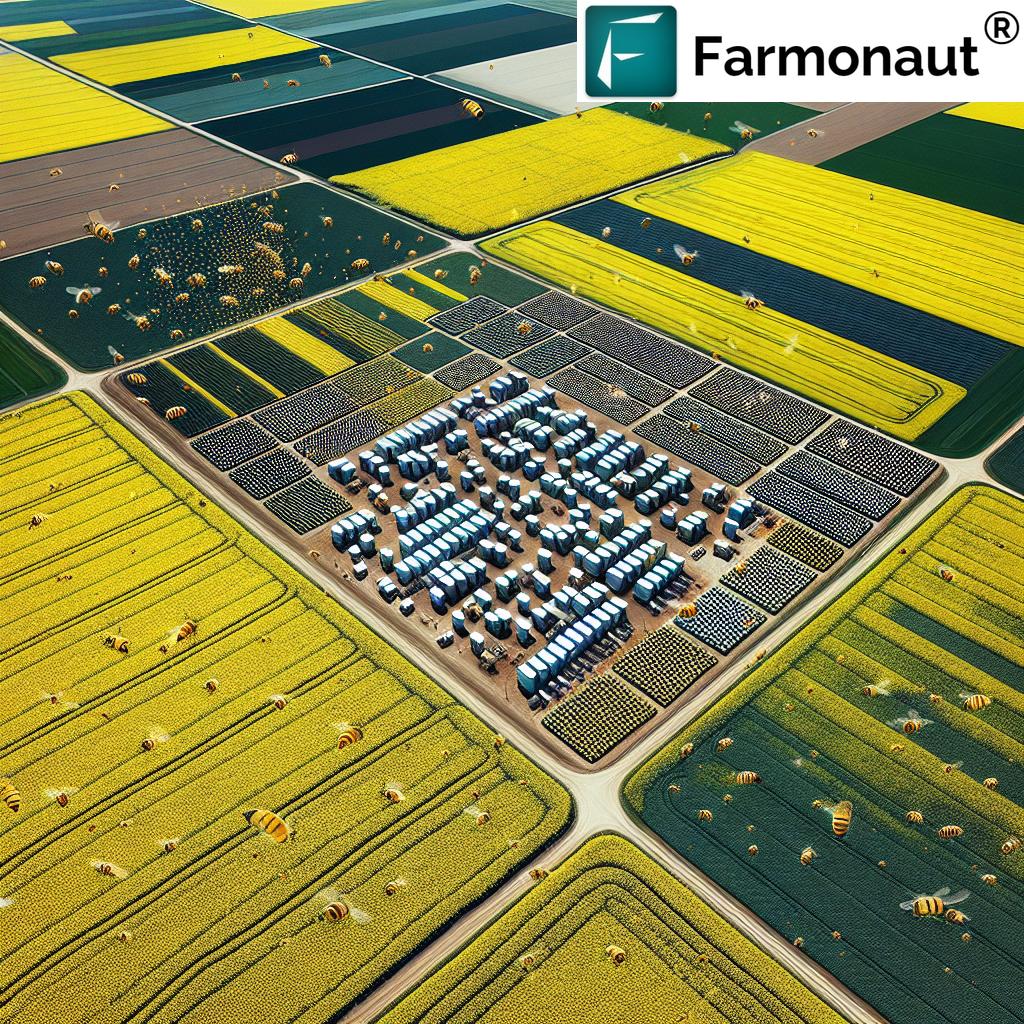
The Shift Towards Biologics in Agriculture
The rise of bee vectoring technology is part of a broader trend towards the use of biologics in agriculture. This shift represents a fundamental change in how we approach crop protection and management:
- Natural Solutions: Biologics harness natural processes to protect crops, aligning with consumer demand for healthier, more sustainable food production.
- Reduced Environmental Impact: Unlike chemical pesticides, biologics have minimal negative effects on the environment and non-target organisms.
- Resistance Management: Biological agents are less likely to lead to pest resistance, offering a long-term solution for crop protection.
- Regulatory Support: Many governments are encouraging the development and use of biological alternatives to chemical pesticides.
As this trend continues, we can expect to see more innovative solutions like bee vectoring technology emerge, further transforming the agricultural landscape.
Global Food Security and Bee Vectoring Technology
In the face of growing global populations and climate change, ensuring food security has become a critical challenge. Bee vectoring technology offers several advantages in addressing this issue:
- Increased Crop Yields: By improving pollination and protecting crops from pests and diseases, bee vectoring can help boost overall food production.
- Sustainable Intensification: This technology allows for increased productivity without expanding agricultural land, preserving natural habitats.
- Climate Resilience: The use of biologics can enhance crop resilience to environmental stresses, a crucial factor in the face of climate change.
- Reduced Chemical Residues: Lower use of chemical pesticides leads to safer food production, addressing concerns about food quality and safety.
As we continue to innovate in the field of sustainable agriculture, technologies like bee vectoring will play a crucial role in ensuring global food security.
Supporting Bee Populations Through Sustainable Practices
One of the most significant benefits of bee vectoring technology is its positive impact on bee populations. By creating an environment where bees are essential not just for pollination but also for crop protection, this technology encourages practices that support bee health and conservation:
- Reduced Pesticide Exposure: Lower use of chemical pesticides minimizes harmful effects on bee populations.
- Improved Foraging Opportunities: The need for consistent bee activity encourages the maintenance of diverse floral resources throughout the growing season.
- Increased Value of Pollinators: Recognizing bees as crucial for both pollination and crop protection elevates their perceived value in agricultural systems.
- Research and Monitoring: Implementation of bee vectoring technology often comes with increased monitoring of bee health and behavior, contributing to conservation efforts.
By aligning agricultural practices with bee conservation, we can create a more sustainable and resilient food production system.
The Role of Technology in Monitoring and Optimizing Bee Vectoring
As bee vectoring technology continues to evolve, the integration of advanced monitoring and data analysis tools becomes increasingly important. At Farmonaut, we’re developing solutions that can complement and enhance bee vectoring practices:
- Satellite-Based Crop Monitoring: Our technology can help track crop health and identify areas that may benefit from targeted bee vectoring efforts.
- AI-Powered Predictive Analytics: By analyzing historical data and current conditions, our systems can help optimize the timing and application of bee vectoring technology.
- Weather Integration: Real-time weather data can be used to predict bee activity and adjust vectoring strategies accordingly.
- Yield Estimation: Advanced imaging and AI can provide accurate yield estimates, helping to quantify the benefits of bee vectoring technology.
These technological advancements ensure that bee vectoring can be implemented with maximum efficiency and effectiveness, further enhancing its value in sustainable agriculture.
Comparison: Bee Vectoring Technology vs. Traditional Pest Management
| Factors | Bee Vectoring Technology | Traditional Pest Management |
|---|---|---|
| Environmental Impact | Low – Uses natural biological agents | High – Relies on chemical pesticides |
| Cost-Effectiveness | High – Combines pollination and pest control | Medium – Separate costs for pollination and pest control |
| Crop Yield Improvement | Up to 30% increase | Varies, typically lower |
| Pollination Efficiency | High – Bees are actively involved | Medium – May require separate pollination services |
| Pest Control Efficacy | High – Targeted and continuous application | Medium – Depends on timing and coverage |
| Sustainability | High – Supports bee populations and ecosystem health | Low – Can harm beneficial insects and soil health |
Future Directions and Research
The field of bee vectoring technology is rapidly evolving, with ongoing research and development promising even more exciting advancements:
- New Biological Agents: Scientists are continually identifying and developing new strains of beneficial microorganisms for use in bee vectoring.
- Expanded Crop Applications: Research is underway to adapt bee vectoring technology for use in a wider range of crops, including greenhouse and indoor farming systems.
- Integration with Precision Agriculture: Future developments may see bee vectoring technology seamlessly integrated with other precision farming techniques for holistic crop management.
- Automated Hive Management: Advanced sensors and AI could lead to smart hives that automatically adjust vectoring strategies based on real-time data.
- Genetic Research: Studies into bee genetics and microbiome could lead to more effective vectoring strategies and improved bee health.
As these areas of research progress, we can expect bee vectoring technology to become an even more powerful tool in the arsenal of sustainable agriculture.
Conclusion: Embracing a Sustainable Future in Agriculture
As we’ve explored throughout this article, bee vectoring technology represents a significant leap forward in sustainable farming practices. By harnessing the natural behavior of bees to deliver biological crop protection agents, this innovative approach offers a unique solution to many of the challenges facing modern agriculture.
From improving crop yields and quality to reducing environmental impact and supporting bee populations, the benefits of bee vectoring are clear. As the technology continues to evolve and integrate with other advanced farming techniques, its potential to transform agriculture on a global scale becomes increasingly apparent.
At Farmonaut, we’re excited to be part of this agricultural revolution. Our satellite-based farm management solutions complement technologies like bee vectoring, providing farmers with the data and insights they need to make informed decisions and optimize their operations.
As we look to the future, the combination of bee vectoring technology, precision agriculture, and data-driven farming practices offers a promising path towards a more sustainable, efficient, and productive agricultural sector. By embracing these innovations, we can work towards ensuring food security, protecting our environment, and supporting the livelihoods of farmers around the world.
The journey towards sustainable agriculture is ongoing, and bee vectoring technology is just one piece of the puzzle. As we continue to innovate and adapt, the future of farming looks brighter than ever. Together, we can create a world where agriculture not only feeds the planet but also nurtures it.
FAQ Section
Q: What is bee vectoring technology?
A: Bee vectoring technology is an innovative agricultural method that uses bees to deliver beneficial microorganisms to crops during pollination, providing both crop protection and improved yields.
Q: How does bee vectoring technology benefit farmers?
A: It offers several benefits including increased crop yields, reduced pesticide use, improved pollination, and more sustainable farming practices.
Q: Is bee vectoring technology safe for bees?
A: Yes, the biological agents used in bee vectoring are specifically chosen to be safe for bees and other beneficial insects.
Q: What types of crops can benefit from bee vectoring?
A: Many crops can benefit, including strawberries, blueberries, sunflowers, almonds, and canola, among others.
Q: How does bee vectoring compare to traditional pesticide use?
A: Bee vectoring is more environmentally friendly, targets specific areas of the plant, and can provide season-long protection without the need for repeated applications.
Q: Can bee vectoring be used in organic farming?
A: Yes, many of the biological agents used in bee vectoring are approved for organic farming, making it an excellent option for organic growers.
Q: How does Farmonaut support sustainable farming practices like bee vectoring?
A: Farmonaut provides satellite-based farm management solutions that complement sustainable practices by offering real-time crop monitoring, AI-driven insights, and precision agriculture tools.









